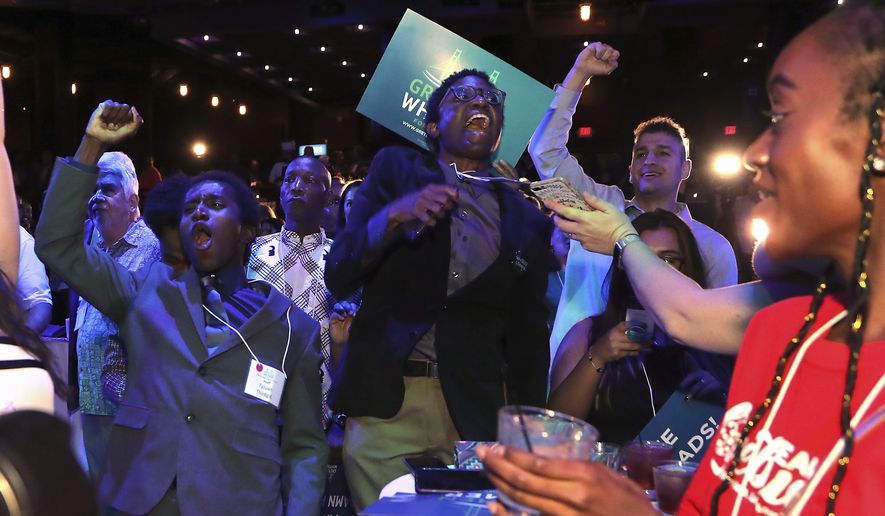Democrats saw a surge in voter turnout in primaries in flyover country this month, leaving party leaders salivating over a potential enthusiasm gap they hope will deliver control of Congress and several major governorships in November.
Turnout records were broken in Wisconsin, Minnesota and Michigan, with Democrats outdistancing Republicans in the gubernatorial race and collecting more votes in numerous primary fights as both parties picked their nominees.
Those are all states where President Trump led Republicans to gains in 2016, but where Democrats say things are swinging back their direction.
“You are seeing a huge turnout in every race from dog catcher to governor,” Jared Leopold, spokesman of the Democratic Governors Association, told The Washington Times. “That sign bodes well for November.”
Political strategists caution against judging too much from primaries — particularly in the Trump era, when the president’s approval ratings are fickle.
Yet they also say there is a clear trend in the primaries.
In House races from Kansas to Colorado where a Republican incumbent is seen as vulnerable, Democrats doubled or even tripled their primary turnout compared to four years ago — the last midterm elections.
In Michigan, where there’s a highly competitive governor’s race, Republicans saw their primary turnout go from about 618,000 in 2014 to 985,000 this year, an increase of 60 percent. But Democrats went from about 513,000 to more than 1.1 million, up about 120 percent.
Wisconsin’s governor’s primary saw both parties expand their turnout by more than 200,000 voters, with Democrats slightly outdistancing the GOP. But Minnesota was another clear win for Democrats, with turnout soaring to nearly 583,000, up from just 191,000 four years ago. GOP turnout, meanwhile, went from 184,000 to 320,000.
“What you are seeing in instance after instance after instance is there is surge in Democratic enthusiasm relative to Republican primary voting,” said John Couvillion, a pollster and political strategist. “That surge has happened enough times for me to conclude that it is just not a fluke.”
Mr. Couvillion said his analysis found that Democrats have accounted for 54 percent of the primary electorate, compared to 46 percent for Republicans. It was the other way around in the 2010 when the GOP flipped control of 63 seats on its way to winning the House and 2014 when Republicans captured the Senate, he said.
Overall, Mr. Couvillion said Democratic turnout this year has increased 82 percent compared to 2014 and 48 percent since 2010. Republican turnout, meanwhile, has increased 24 percent since 2014 and increased 4 percent since 2010, he said.
Steve Mitchell, a Detroit-based GOP pollster, warned against drawing a straight line between primary turnout and general election outcomes, because much of it depends on internal party competition and how many people are seeking nominations for highly-prized seats.
Still, he said Democrats are going to turn out in force in November, ready to express anger at President Trump.
“So the question then becomes: Are the Republicans going to turn out in November or not?” he said. “That is really the big question that goes unanswered.”
Rick Gorka, spokesman for the Republican National Committee, said so far under Mr. Trump, GOP voters have shown up when it counts.
“Republicans have won nearly every high-profile special election this cycle,” Mr. Gorka said, alluding to the party’s success in House races. “If Democrats want to point to turnouts in primaries and hang their hats on moral victories, that is fine. Republicans will point to our electoral wins when the results actually mattered.”
Indeed, Mr. Trump is predicting a GOP wave in November, saying he figures he’ll get Republicans to turn out.
“As long as I can get out and campaign, I think they’re going to win, I really do,” Mr. Trump told The Wall Street Journal this week. “It’s a lot of work for me. I have to make 50 stops, it’s a lot. So, there aren’t a lot of people that can do that, physically. Fortunately, I have no problem with that.”
Mr. Trump and fellow Republicans say he proved that earlier this month in Ohio, where a last-minute campaign stop may have helped stave off an embarrassing defeat in a special congressional election in a deeply red district.
But a Pew Research poll of registered voters released Thursday found Democrats are more engaged, showing more up at rallies, donating to candidates and volunteering for campaigns.
Mr. Leopold said Democrats experienced similar levels of voter enthusiasm in the 2017 governor’s race in Virginia and New Jersey, where high turnout in the primary races served as a preview of the big victories to come in the general election.
“Everywhere you are Democrats are excited to come out in vote,” he said. “That is true in the primary and that is going to continue to be true in November.”
• Seth McLaughlin can be reached at smclaughlin@washingtontimes.com.




Please read our comment policy before commenting.